Icons
and Churches of the Old Rus'
An
Introduction
Icons
in the Eastern Church and especially in Russia are living
manifestations of the portrayed saint or event. Spiritually they are
much more than a painting of Christ, the Virgin, or the
Transfiguration. They have the spiritual power of healing and
consoling, or of protecting the land or a town better than an army.
No wonder then that Orthodox believers venerate their icons with a
faith and fervor that we have mostly forgotten in the enlightened
Latin West - Bavaria comes to mind as an exception...
-
|
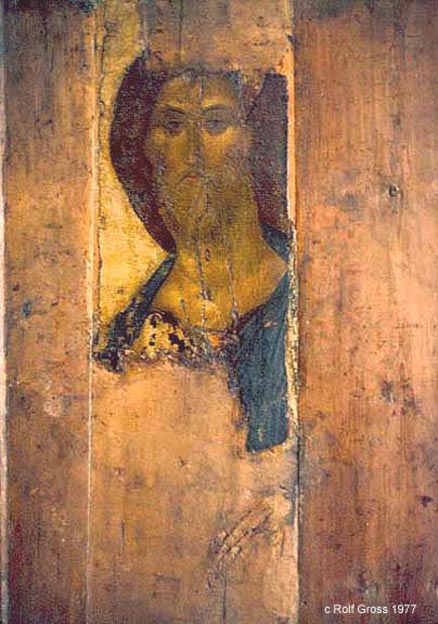
|
One
of the most haunting Russian icons is Rublev's
Christ from the Deesis in Zvenigorod.
In a psychological sense an icon is a two-dimensional
image, a reflexion of the deepest substrate of the human soul and
of the Russian dusha in
particular. They allow one to gain an insight into much more in
Russia than her Orthodx faith. Our art-historical curiosity,
however, is entirely irrelevant to the Church and its believers,
and it becomes a real challenge to elucidate the provenance and
dates of a particular icon – as I have valiantly tried to
do.
The
painting of icons began in the Christian Near East in the 5th
century.
Some of the oldest (6th
cent)
are in the Monastery of St. Catherine on Mt. Sinai. They appear
in Kievan Rus' in the 10th
century.
By the 14th
century
a specific Russian style had evolved in Northern Rus', which
culminates in the paintings of Theophanes the Greek, Dionysus,
and most gloriously in those of Andrei Rublev and his school in
the early 15th
century.
Since the 1920s many icons have been moved to the safety
of museums, have been freed of their silver bemas
(precious
metal coverings), cleaned
of the soot of candles and kisses and subjected to the scrutiny
of modern restaurateurs. Copies replaced them in the churches.
|
-
|
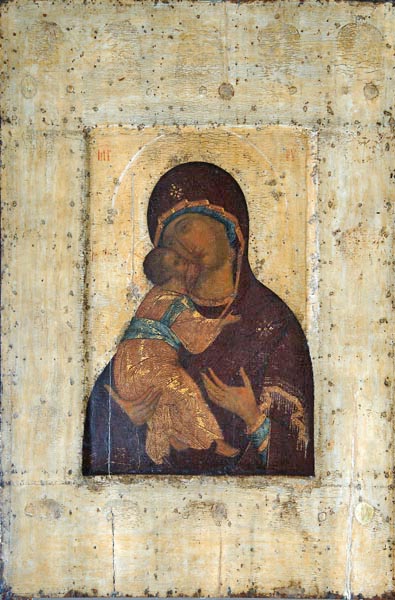
|
The
greatest Russian icons have a sweetness which is not found in
comparable religious paintings of Greece, Bulgaria, or Syria.
Influences from the more relaxed traditions of Macedonia,
Georgia, and Byzantine Italy are, however, noticable in the 12th
century.
By the time Italian Renaissance architects began working in
Moscow in the 17th
century
icon painting had artistically
and esthetically
declined
- which albeit has not diminished the spiritual power of even the
latest paintings.
For
visual reasons I have tried to associate specific icons with the
churches they originated from, an often haphazard endeavor,
because these miraculous images were frequently moved to other
places by the powerful of the land – viz.,
the
Soviet authorities who hid them in the basements of their
museums.
My
collection is ordered by their location and date.
Andrei
Rublyev, Our Lady of Vladimir, 1408
|
-
|
The
precious icons in the possession of a church are displayed in an
Iconostasis, a high wood or masonry wall which separates the Holy
of the Holiest from the ordinary world. In most churches the
iconostases are heavily encrusted with repoussé gold or
silver bemas.
This is an exceptional fresco which has recently been rcovered
from under plaster. The images are arranged in several tiers
(“ranges”): In the lowest range the local icon is
displayed on the opposite side of the “Golden Door”.
The icons of the next tier, the “Deesis”, show a
canonized arrangement of large, elongated images of saints,
archangels, the Virgin and the Baptist on both sides of Christ in
Majesty, who resides in an elliptical mandorla.
Rostov
Veliki, Church of the Resurrection, 17th
century.
|
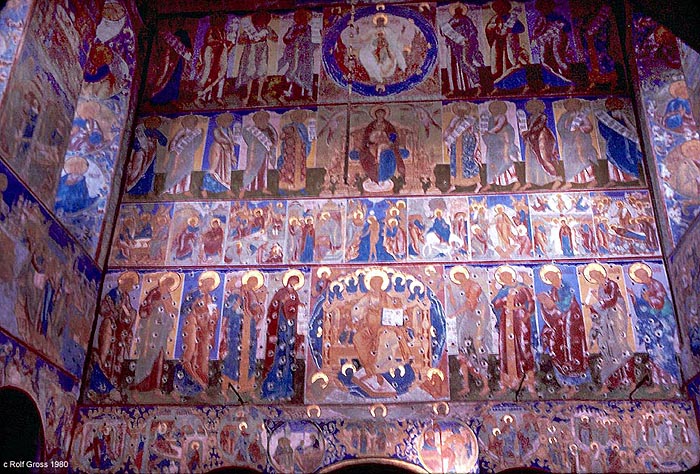
|
For
one of the most splendid iconosasis see Andrei Rublyev's Iconostasis
of the Trinity Cathedral in the Sergiev Lavra.
Above
the Deesis is a tier of Feast Days, smaller icons depicting the high
holidays of the Orthodox Faith. The highest range occupies images of
Old Testament prophets and church fathers. Closer
scrutiny of the Feast Days of the Trinity-Sergiev iconostasis shows
that the Eastern Church celebrates holidays which are barely
mentioned in the West, like the Assumption of the Virgin and her
presentation in the temple.
-
|
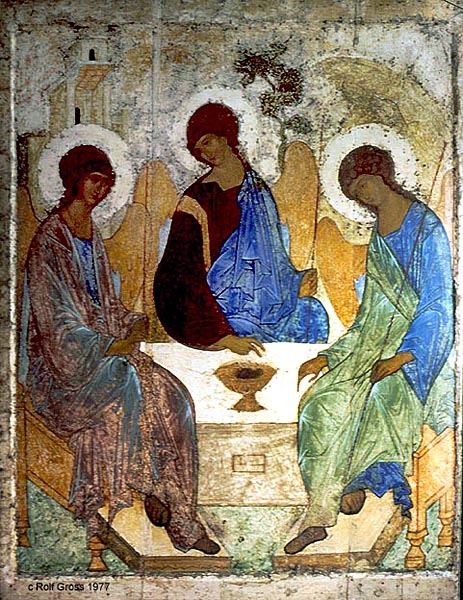
|
These pecularities are due to
the ever present veneration of the Mother of God in Russia and
also to a body of complex edicts which, for example, forbade the
presentation of God Father. The prophetic icon of the Trinity in
the Old Testament – Abraham receiving three messengers from
God - is such a case: it represents the “New Testament”
Trinity, which is very rarely present in the older sactuaries.
Arguably the most revered icon
of Russia is the local icon of the Trinity Cathedral in the
Sergiev Lavra, next to the door in the lowest range of the
iconostasis:
Andrei
Rublyev, Old Testament Trinity, Trinity Cathedral of the Sergiev
Lavra, 1425.
|
The
Churches that
house these images are equally different from the churches in the
West. The Roman basilica, designed for large crowds – and the
display of Byzantine imperial might - has never acquired a foothold
in Russia proper. They do exist in Georgia, Greece, and the Balkans.
Russian churches are, like in ancient Greece, “Jewel Boxes of
the Saints”, enclosures for the Holy Images.
-
|
Like
the icons they can be seen as three-dimensional mandalas
expressing another level of images of the soul. My favorite
example is the small church in the Andronikov Monastery (12th
cent),
the oldest surviving church in Moscow. Early Churches in Novgorod
and in Vladimir show the same architectural style: a square floor
plan, a varyingly high rectangular body with a single drum and
cupola crowning this iconic architecture.
Church
of the Savior in the Andronikov Monastery in Moscow (12th
cent)
|
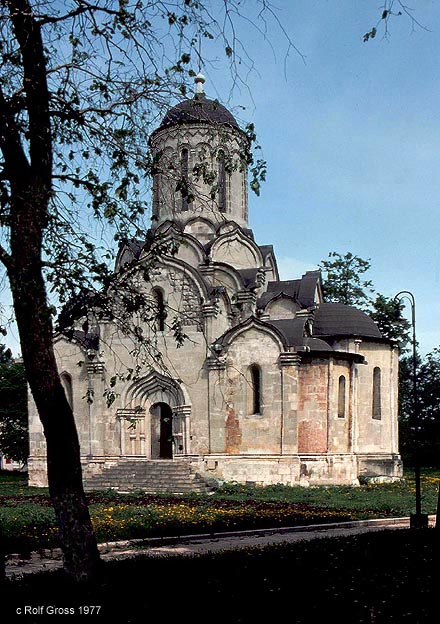
|
-
|

|
In the copula of their frescoed
interior resides the Holy Face of Christ the Savior, the center
of the mandala.
The
interior of the Church of the Resurrection in Rostov Veliki.
|
-
|

|
Historically
this design first appeared in the 11th
century
in Vladimir, probably built by Georgian architects, in Novgorod,
where Macedonian craftsmen worked, and finally - indigenously
Russian - in the 12th
century
in the many small churches of Pskov.
The
oldest churches in Russia were constructed of wood and were
invariably destroyed by frequent fires. The surviving wooden
churches are from the 18th
century
and were rescued and conserved only in the past fifty years.
Dimitry
Cathedral, Valdimir, 1194-1197
|
-
|
Moscow,
which historically was the last capital of the Old Rus', became
architecturally important only in the 14th
to
16th
century.
With one or two exceptions the
churches of the Kremlin were built by Italian architects hired by
the Tsars. Astonishingly, they faithfully adopted the tastes and
ideas of their new clients, only a few outside ornaments remind
one of the contemporary Renaissance architecture of their
homeland.
In
the 18th
century
Russian architecture espoused the Baroque, a by then fashionable
style more akin to the mentality and taste of the powerful elite
than the formal severity of the enlightened Renaissance. With
Peter the Great the time of the Old Rus' came to an end.
The
Archangel Cathedral in the Kremlin of Moscow, 1504 - 1508
|
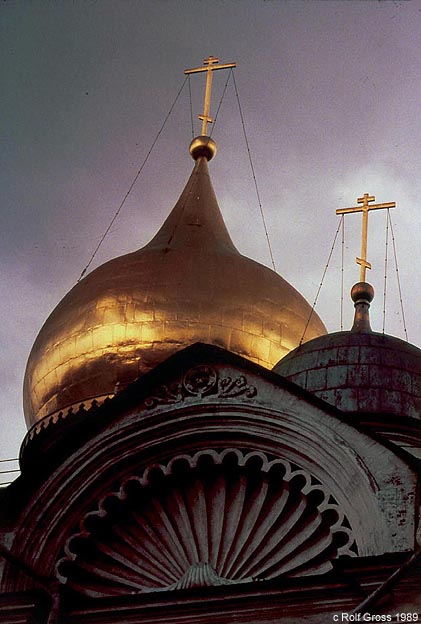
|
-
|
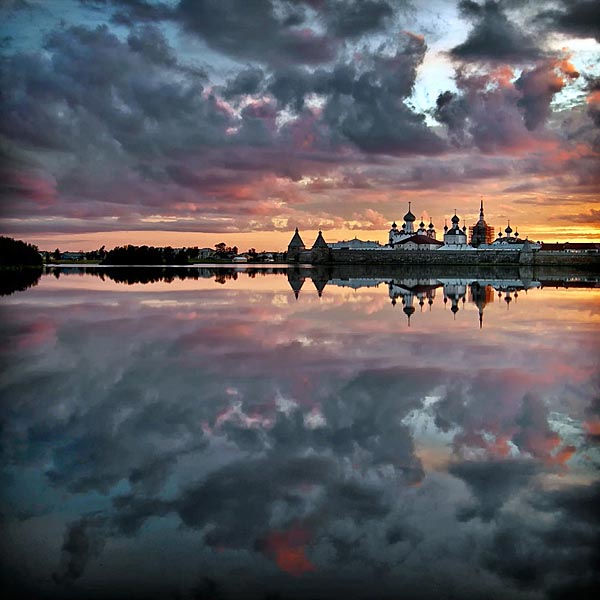
|
Finally I have to confess that,
seduced by the beauty of the photographs I found in the internet,
I included a number of buildings and places, which I did not
visit and would have disregarded architecturally otherwise. I had
forgotten how beguilingly glorious the colorful fairy towns and
their golden copulas can appear in the monotonous, flat Russian
landscape, especially after having been renovated in the last
fifteen years.
The
ill-famed Solovetsky Monastery on an island in the White
Sea.
Founded
in 1429 it was the greatest citadel of Christianity in the
Russian North before being turned into a Tsarist place of exile
and later into Soviet labor camp.
This
photo is from skyplace.org
All
other photos RWFG 1977-1989
|
This
website is based on a Google-Earth file which is linked to in each
chapter. It shows the location of the places and many additional
Panoramio photos that annotate the pictures presented here.
Last
not least this collection is dedicated to the memory and to the
enjoyment of the many friends in Moscow who hosted and drove me
around during eight extended visits between 1969 and 1989. I came as
a physicist invited by the Soviet Academy of Sciences and left wiser
and enriched by the visual insights into Russia's enigmatic culture.
An
excellent review of the subject appeared just at the right time with
a
large exhibition at the Louvre in Paris:
Holy
Russia
Russian Art from the Beginnings to Peter the
Great
March 5 to May 24, 2010
RWFG,
March 2010








